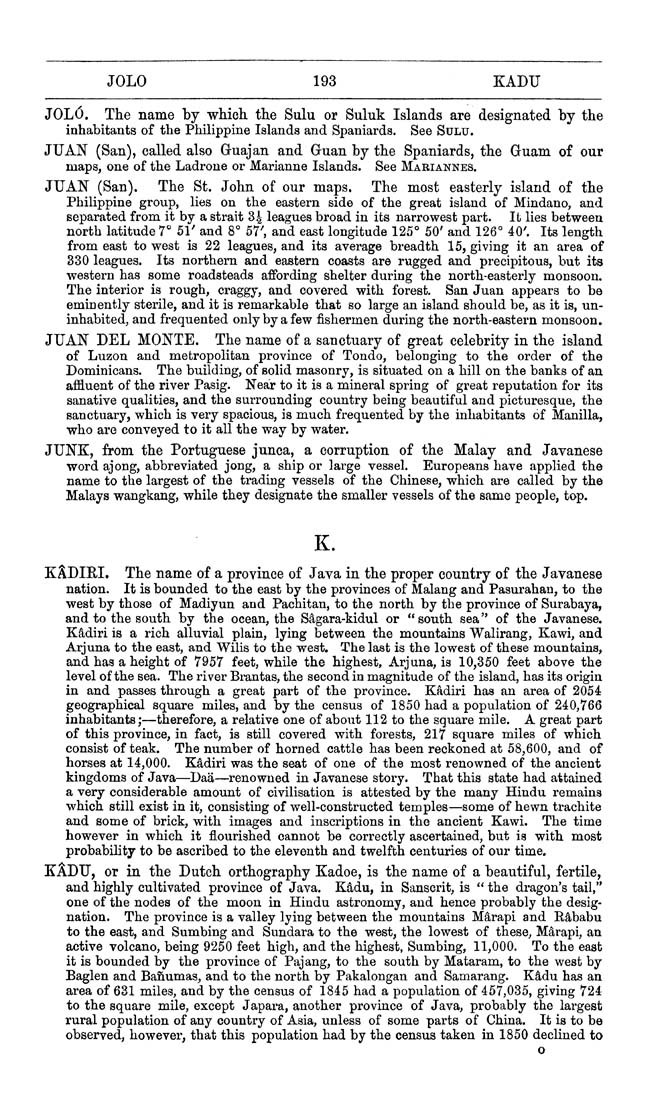JOLO 193 KADU
J0L6. The name by which, the Sulu or Suluk Islands are designated by the
inhabitants of the Philippine Islands and Spaniards. See Sulu.
JUAN (San), called also Guajan and Guan by the Spaniards, the Guam of our
maps, one of the Ladrone or Marianne Islands. See Mariannes.
JUAN (San). The St. John of our maps. The most easterly island of the
Philippine group, lies on the eastern side of the great island of Mindano, and
separated from it by a strait 3| leagues broad in its narrowest part. It lies between
north latitude 7" 51' and 8° 57', and east longitude 125° 50' and 126° 40'. Its length
from east to west is 22 leagues, and its average breadth 15, giving it an area of
330 leagues. Its northern and eastern coasts are rugged and precipitous, but its
western has some roadsteads affording shelter during the north-easterly monsoon.
The interior is rough, craggy, and covered with forest. San Juan appears to be
eminently sterile, and it is remarkable that so large an island should be, as it is, un¬
inhabited, and frequented only by a few fishermen during the north-eastern monsoon.
JUAN DEL MONTE. The name of a sanctuary of great celebrity in the island
of Luzon and metropolitan province of Tondo, belonging to the order of the
Dominicans. The building, of solid masonry, is situated on a hill on the banks of an
aflluent of the river Pasig. Near to it is a mineral spring of great reputation for its
sanative qualities, and the surrounding country being beautiful and picturesque, the
sanctuary, which is very spacious, is much frequented by the inhabitants of Manilla,
who are conveyed to it all the way by water.
JUNK, from the Portuguese junca, a corruption of the Malay and Javanese
word ajong, abbreviated jong, a ship or large vessel. Europeans have applied the
name to the largest of the trading vessels of the Chinese, which are called by the
Malays wangkang, while they designate the smaller vessels of the same people, top.
K.
KS-DIRI. The name of a province of Java in the proper country of the Javanese
nation. It is bounded to the east by the provinces of Malang and Pasurahan, to the
west by those of Madiyun and Pachitan, to the north by the province of Surabaya,
and to the south by the ocean, the S^gara-kidul or "south sea" of the Javanese.
Kadiri is a rich alluvial plain, lying between the mountains Walirang, Kawi, and
Arjuna to the east, and Wilis to the west. The last is the lowest of these mountains,
and has a height of 7957 feet, while the highest, Arjuna, is 10,350 feet above the
level of the sea. The river Brantas, the second in magnitude of the island, has its origin
in and passes through a great part of the province. Kadiri has an area of 2054
geographical square miles, and by the census of 1850 had a population of 240,766
inhabitants;—therefore, a relative one of about 112 to the square mile. A great part
of this province, in fact, is still covered with forests, 217 square miles of which
consist of teak. The number of horned cattle has been reckoned at 58,600, and of
horses at 14,000. K4diri was the seat of one of the most renowned of the ancient
kingdoms of Java—Daa—renowned in Javanese story. That this state had attained
a very considerable amount of civilisation is attested by the many Hindu remains
which still exist in it, consisting of well-constructed temples—some of hewn trachite
and some of brick, with images and inscriptions in the ancient Kawi. The time
however in which it flourished cannot be correctly ascertained, but is with most
probability to be ascribed to the eleventh and twelfth centuries of our time.
KADU, or in the Dutch orthography Kadoe, is the name of a beautiful, fertile,
and highly cultivated province of Java. KS,du, in Sanscrit, is " the dragon's tail,"
one of the nodes of the moon in Hindu astronomy, and hence probably the desig¬
nation. The province is a valley lying between the mountains Marapi and R^babu
to the east, and Sumbing and Sundara to the west, the lowest of these, Marapi, an
active volcano, being 9250 feet high, and the highest, Sumbing, 11,000. To the east
it is bounded by the province of Pajang, to the south by Mataram, to the west by
Baglen and Banumas, and to the north by Pakalongan and Samarang. K^du has an
area of 631 miles, and by the census of 1845 had a population of 457,035, giving 724
to the square mile, except Japara, another province of Java, probably the largest
rural population of any country of Asia, unless of some parts of China. It is to be
observed, however, that this population had by the census taken in 1850 declined to
o
|








